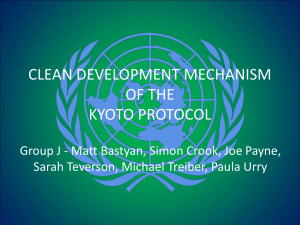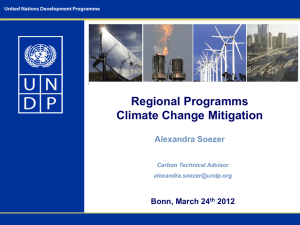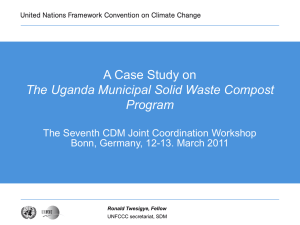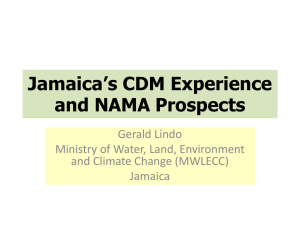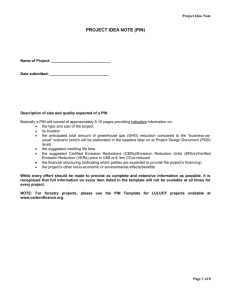What do developing countries get from the CDM
advertisement
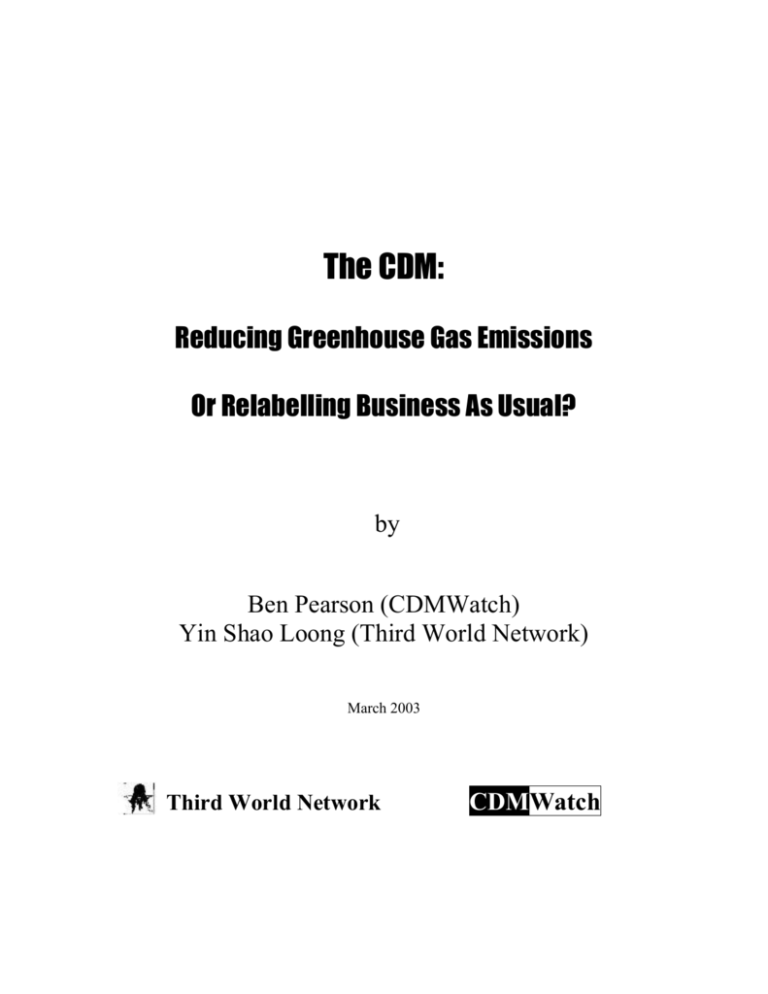
The CDM: Reducing Greenhouse Gas Emissions Or Relabelling Business As Usual? by Ben Pearson (CDMWatch) Yin Shao Loong (Third World Network) March 2003 Third World Network CDMWatch CDMWatch Third World Network www.cdmwatch.org www.twnside.org.sg CDMWatch Third World Network The CDM: reducing greenhouse gas emissions or relabelling business as usual? How the “environmental” additionality test undermines the Kyoto Protocol and represents a missed opportunity for developing countries “The purpose of the additionality test is to make sure that projects are given credits only if they would not have happened under a business as usual scenario”. The EU’s PROBASE program1 “… it is now clear that additionality refers to environmental additionality…..” World Business Council on Sustainable Development2 “In our opinion, the environmental additionality test does not screen out business as usual projects…..” Société Générale de Surveillance, a CDM validator3 Summary The Clean Development Mechanism (CDM) of the Kyoto Protocol allows industrialised countries with a greenhouse gas reduction commitment – so-called Annex I countries – to invest in emission reducing projects in developing countries and claim credit for the reductions achieved. In theory, this will help reduce Annex I compliance costs, while providing new financing for sustainable development in the south. Yet early experience suggests the CDM will prove to be a negative factor in terms of sustainable development and greenhouse gas reductions. Among the most disturbing trends is the deliberate undermining of the concept of “additionality” by the business community and industrialised countries. Additionality is the crucial test of whether a CDM project results in emission reductions that are in excess of what would have occurred under a business as usual scenario, and thus whether the project should be awarded carbon credits that can be used by an Annex I party to meet its Kyoto commitments. To keep credit prices down, Annex I buyers are promoting a so-called “environmental” additionality test that, perversely, validates business as usual projects and will create a large loophole in the 1 PROBASE briefing note on additionality, undated. Submission by the IETA, 11.7.02, available from cdmwatch@indosat.net.id 3 email from SGS to IRN, 25.10.02. 2 www.cdmwatch.org www.twnside.org.sg CDMWatch Third World Network Annex I emission reduction targets through the generation of spurious credits. As developing countries are most vulnerable to climate change, any further weakening of the Kyoto Protocol is manifestly not in their interest. The undermining of additionality also dilutes the potential benefit of the CDM to developing countries on the project level. A credible additionality test could see extra investment directed to new projects that otherwise wouldn’t have happened. A test that allows business as usual projects will merely provide a top-up to existing projects that were going ahead anyway. Related to this is the price of carbon credits: if business as usual projects are made eligible, the price of credits can be kept artificially low, as there is no requirement to show that the carbon revenue was a factor in the project happening. If additionality is enforced, the price will have to rise to a level at which it can make a difference. Ultimately, then, the question of who benefits from the CDM will be greatly influenced by the question of whether a credible additionality test is enforced. If it is not, the CDM will result in no new projects in the south, and another loophole in the Annex I Kyoto commitments. Developing countries should demand much more. Reinterpreting additionality to allow business-as-usual Paragraph 43 of the 2001 Marrakech Accords of the Kyoto Protocol provides the following explanation of additionality: “A CDM project activity is additional if anthropogenic emissions of greenhouse gases by sources are reduced below those that would have occurred in the absence of the registered CDM project activity”. If CDM projects are to result in bona fide greenhouse gas reductions then the interpretation of this paragraph must be based on commonsense: if a project will be implemented without CDM registration then it is non-additional. As the EU’s PROBASE program on accounting and baselines states: “It is generally recognised that credits for GHG emissions reduction should only be granted for projects that are additional; that is, for projects which would not have taken place in the absence of the crediting procedure or trading scheme”4. When the CDM Executive Board issued its first draft of the CDM Project Design Document (PDD) in July 2002, it included an additionality test that reflected this commonsense requirement. Developers were asked to: “Provide affirmation that the project activity does not occur in the absence of the CDM”5. 4 5 PROBASE briefing note on additionality, undated. CDM PDD Version 1, 3.7.02. available from cdmwatch@indosat.net.id www.cdmwatch.org www.twnside.org.sg CDMWatch Third World Network An explanatory paragraph elaborated: “…the project itself would not occur in the absence of the CDM or the ability to register the proposed project activity as a CDM project activity”6. The Board’s formulation was strongly rejected by business groups and Annex I countries. It was, they argued, a “financial” or “investment” additionality test which had been rejected in favour of an “environmental” or “emissions” additionality test in the Marrakech Accords. The European Union went so far as to claim that paragraph 43 of the Accords, cited above, “specifically refers to emissions additionality”, which it clearly does not7. In fact, the Marrakech Accords contain reference to none of these modified additionality tests, and provides no legal basis for rejecting one in favour of the other, nor for opposing the Board’s test. What really provoked concern among Annex I countries and the business community was that this test would have ruled out business as usual projects and caused the price of carbon credits to rise. Higher credit prices in turn would have interfered with the real purpose of the CDM for Annex I investors – reducing the cost of compliance with their Kyoto targets. The pressure paid off. The final version of the PDD contains a formulation that lacks the explicit requirement to show that the project would not have happened without the CDM, and returns to the more ambiguous language of the Marrakech Accords. A project must now provide a: “Brief explanation of how the anthropogenic emissions of anthropogenic greenhouse gas (GHGs) by source are to be reduced by the proposed CDM project activity, including why the emission reductions would not occur in the absence of the proposed project activity…”8. In the absence of further clarification or guidance from the Executive Board, this language is now being interpreted as “environmental” additionality by developers and validators, an interpretation that opens the door for business as usual projects. “Environmental” additionality The common understanding of the environmental additionality test is that a project must result in less emissions than the baseline or alternative scenario. A wind project, for example, may posit a coal plant as the alternative scenario and show that it has lower emissions and is thus environmentally additional. But there is no requirement to demonstrate that the project is happening instead of this baseline because of the incentive of CDM registration. Expressed differently, environmental additionality compares the difference in emissions “with” and “without” the project, but does not test the difference in emissions “with” and “without” the CDM. 6 ibid Submission by Denmark, The European Commission, Germany, Italy, the Netherlands, Spain, Austria, France, Finland, Portugal, Sweden, Ireland, Belgium, Greece and the UK, to the CDM PDD Version 1, undated. Available from cdmwatch@indosat.net.id 8 CDM PDD, www.unfccc.int/cdm 7 www.cdmwatch.org www.twnside.org.sg CDMWatch Third World Network As a result, environmental additionality does not screen out business as usual projects. It does not ask if the project would have happened without the CDM, only if there would have been more emissions had the project not been implemented. In the case of a business as usual project this is a fraudulent comparison for the purposes of additionality testing, as the “without project” scenario was never going to Esti Dam happen. Awarding the project credits for “avoiding” this The inadequacy of the current additionality test is scenario means giving credits for illustrated by one of the potential Dutch projects – the Esti avoiding emissions that were Dam in Panama. The project documentation submitted by never going to occur. If, for the Esti developers did not include any explanation for why example, the wind plant is this project is additional. On the contrary, the already being built and will be documentation notes: completed without CDM registration, then the difference “Actually the project is 52% advance [sic] in the in emissions between it and the construction and we do not foresee problems to be on line coal plant is irrelevant. The only by November 2003”. two scenarios that are possible are “wind project that is Failure to gain CDM registration would clearly be registered under the CDM” and irrelevant to the completion of this project, and “wind project that is not”, with commonsense tell us that there are only two possible identical outcomes in terms of scenarios: completion of Esti with registration as a CDM greenhouse gas emissions. project; and completion of Esti without registration as a Indeed, by providing spurious CDM project. The emissions in both scenarios are the credits that can be used by an same, and there is no basis for the awarding of carbon Annex I country to avoid making credits. real reductions, registration of the wind project actually leads to However, if the currently accepted application of an increase in emissions environmental additionality is used, this nearly completed globally. project may be considered additional. The alternative scenario presented by the project developer is equivalent This hypothetical example thermal capacity which would allegedly emit 3.5MtCO2e reflects the reality of many CDM more than the Esti Dam. Under the environmental projects now moving through the additionality test, this may be enough to be considered approval process. Many are well additional. Yet the difference in emissions between Esti advanced in their and the identified baseline of new thermal capacity is implementation, in some cases obviously irrelevant in terms of climate protection, as the fast approaching completion; thermal capacity was not going to be built, and the 3.5Mt they are by definition business as CO2e was not going to be emitted. Esti’s registration or usual projects that will be otherwise as a CDM project will not change this. completed with or without CDM Determining additionality on the basis of this alternative registration. Yet they are scenario is clearly fraudulent, as the alternative scenario claiming to be additional by was never going to happen. Why, then, should the Dutch comparing their emissions to Government be allowed to re-label this a CDM project and more carbon-intensive “without reduce their Kyoto target by 3.5Mt? www.cdmwatch.org www.twnside.org.sg CDMWatch Third World Network project” scenarios, despite the obvious fact that these scenarios will not and were never going to happen [see “Esti Dam” box]. The porous nature of the environmental additionality test has been conceded by one of the largest prospective CDM validators, Société Générale de Surveillance (SGS), which is validating a number of the potential Dutch projects. In response to comments by the International Rivers Network (IRN) about the non-additionality of a project in Peru, SGS wrote that its instructions from the Dutch Government required only an environmental additionality test, and that “In our opinion, the environmental additionality test does not screen out business as usual projects…..”9. Compare this assessment to PROBASE’s explanation of an additionality test: “The purpose of the additionality test is to make sure that projects are given credits only if they would not have happened under a business as usual scenario”10. This is an absurd situation. The environmental additionality test simply does not do what an additionality test is designed to do. The scale of the problem How many of the current potential CDM projects would meet the additionality test first proposed by the Executive Board, and be able to demonstrate that “the project activity does not occur in the absence of the CDM”? Arguing against the Board’s proposed test, the International Emissions Trading Association (IETA) cautioned: “…most of the projects in the portfolio of the Worldbank and the Dutch ERUPT/ CERUPT would not meet this additionality criteria”11. IETA’s assessment is consistent with SGS’s assessment in its letter to IRN that “Other projects submitted to CERUPT are, in my opinion, more blatant business as usual projects”12. The Cerupt and PCF programs between them account for 45Mt CO2e so far. According to recent modeling estimates the CDM as a whole could generate about 370Mt a year, or almost 2Gt overall, of carbon credits in the first commitment period.13 If these credits are sourced from business as usual projects they will create a massive loophole in the Annex I reduction targets, and a negative outcome for the climate. The typical business response to calls for tighter additionality standards is warnings about reduced deal flow and a smaller CDM market. This misses the point entirely, and perhaps deliberately. The value and effectiveness of the CDM must always be seen in the broader context of the Protocol from which it derives, and its contribution to international efforts to combat global warming. Ultimately, a non-additional CDM project is worse for the 9 email from SGS to IRN, 25.10.02. http://www.northsea.nl/jiq/probase/bnote8.doc 11 Submission by the IETA, 11.7.02, available from cdmwatch@indosat.net.id 12 op cit. 13 Jotzo, F., and Michaleowa, A., “Estimating the CDM market under the Marrkech Accords”, in Climate Policy 2 (2002), 179-196; www.climatepolicy.com. 10 www.cdmwatch.org www.twnside.org.sg CDMWatch Third World Network atmosphere than no CDM project, as it allows an industrialised country to use spurious credits to reduce the emission reduction target that they agreed under the Kyoto Protocol, resulting in more greenhouse gases being released into the atmosphere than would otherwise have been the case, and diverting investment from real reduction opportunities. Additionality thus directly influences how effective the Kyoto Protocol will be as a first step in addressing climate change. If it is a stumble, the biggest losers will be developing countries. It is they who are most vulnerable to the impacts of climate change and the least able financially and technologically to adapt. It is they who should be most worried by the attempts to subvert additionality. Non additional projects means reduced benefit to the south A credible additionality test also helps determines how much benefit developing countries will get from the CDM on the project level. If the CDM is dominated by nonadditional projects, then it will be a missed opportunity: Wasted investment: Instead of being a mechanism that mobilises additional capital and financing for new projects, the CDM will enhance the return on existing projects whose completion, and Balrampur biomass project – subsidising Annex I compliance benefits to the host country, are already The 19MW Balrampur biomass CDM project in Uttar Pradesh, assured. It will in effect be a top-up fund India, is the most blatantly non-additional project yet to begin the CDM approval process. The project is already complete and is through which Annex due to begin commercial operation in early 2003. The benefits I investors provide a that Balrampur will provide in terms of local and global relatively small environmental improvements, employment and electricity are payment to developers thus guaranteed, and its current financial health is indicated by in return for spurious credits that allow them the developers boast that they expect a “Handsome rate of return on investment and debt service coverage ratio”. The CDM to meet their Kyoto played no part in Balrampur’s completion. Instead, the project commitments at a was made possible by tax breaks, subsidies and favourable power discount rate [see purchase conditions provided by the Indian Central and State Balrampur box]. Governments as part of its efforts to promote the nonconventional power sector. If the project is registered under the In the case of projects CDM, the carbon revenue it receives will be merely a sweetener which are being for an already profitable project whose completion was never in developed by western doubt. This will be overwhelmingly to the benefit of the Annex I companies or their purchaser of the credits that Balrampur generates; marginal subsidiaries, it seems abatement costs in Europe are about $20-25, probably more in likely that very little Japan; Balrampur will likely generate credits for about $4-5. In of this carbon fact, by allowing an Annex I country to buy spurious credits from payment will remain an existing project that was made possible by Indian Government in the host country. At subsidies, the Indian Government is effectively subsidising a time when industrialised countries in their efforts to reach their Kyoto developing country targets. energy sectors require www.cdmwatch.org www.twnside.org.sg CDMWatch Third World Network massive amounts of new investment and financing, this represents a wasted opportunity. The scale of CDM financial flows will be determined by the needs of industrialised countries for cheap carbon offsets, instead of the needs of developing countries for new funding for sustainable development. Low carbon price: weak additionality rules help make carbon credits cheap. Because there is no need to show that the CDM was a factor in the project going ahead, the price can be set an artificially low level, below the real price of achieving extra reductions in the south14. The claim that the US withdrawal from Kyoto is responsible for low CDM credit prices doesn’t bear scrutiny: the World Bank was assuring its Annex I investors of carbon credits at or below $5/tonne CO2e in April 200015. As only business as usual projects will deliver large volumes of cheap credits, the rules are being shaped to accommodate them, with additionality being the most important. If additionality was enforced, the price of credits would have to rise. Inequitable share of projects: The CDM is mandated to “promote equitable geographic distribution of clean development mechanism project activities at regional and subregional levels”. Non-additionality will exacerbate the tendency towards the exact opposite. If CDM investment flows to business-as-usual projects, then inevitably it will flow to those countries that already attract the lion’s share of foreign direct investment (FDI), as it is already doing16. Those who currently miss out on FDI, and gained little from the AIJ pilot phase, will miss out again. Reduced adaptation fund: An additionality test that allows business-as-usual and lowers the price of carbon also creates a cruelly ironic situation for those developing countries who are most vulnerable to climate change. As well as weakening the Kyoto Protocol, it reduces the amount that will flow into the developing country adaptation fund, which is a percentage of carbon revenues from CDM projects. Countries like those in AOSIS who are the most vulnerable to climate change will get nothing from the CDM in terms of projects and new investment, and will watch from the sidelines as others use it in ways that undermine the Kyoto Protocol, and reduce the resources available for them to adapt. A lose-lose situation for those who can least afford it. Conclusion The current attempts to undermine additionality are designed to create a CDM that delivers artificially cheap carbon credits to Annex I buyers, lowering the cost of compliance with their Kyoto commitments. Far from promoting sustainable development and climate protection, it will promote the relabelling of business-as-usual in the south, and the further erosion of emission reduction targets in the north. The big losers will be developing countries who are most in need of new financing for sustainable development, 14 in the case of projects relying on methane capture the current price may result in additional projects PCF Business Plan and Budget, April1 – June 30, 2000; www.prototypecarbonfund.org 16 “The CDM: Clean Development or Development Jeopardy?”; Third World Network and CDM Watch; http://www.twnside.org.sg/title/cop8a.doc. 15 www.cdmwatch.org www.twnside.org.sg CDMWatch Third World Network and most vulnerable to climate change. Alternatively, a credible application of additionality might result in new and additional activity, and see carbon revenues by necessity directed towards projects which need additional funds to proceed. An inevitable corollary of the credible application of additionality would be an increase in the price of carbon credits, to the obvious benefit of host countries. The question of whether the CDM includes a credible additionality test for projects is therefore largely a question of whether the mechanism will be designed to benefit the north or the south. The current application of environmental additionality has no legal basis in the Marrakech Accords or any of the official CDM texts. Developing countries must act to reject this false and self-serving interpretation. Given that they will host CDM projects, and must approve them, they are in a good position to insist on credible additionality testing. Policy advice summary Restore the Executive Board’s first additionality test, whereby developers should “Provide affirmation that the project activity does not occur in the absence of the CDM”. There is nothing in the Marrakesh Accords which invalidates this test. The positive effects would likely be as follows: a) Ensures the CDM results in new and additional projects; b) An increased carbon price; c) An increased Adaptation Fund. d) Preserve the integrity of developing country negotiating efforts in the Kyoto process. Allowing important CDM rules to be misinterpreted so as to benefit Annex I investors sends the wrong message about the role of developing countries in future negotiations. Ben Pearson CDM Watch Indonesia cdmwatch@indosat.net.id Yin Shao Loong Third World Network Malaysia shaoloong@myjaring.net March 2003 www.cdmwatch.org www.twnside.org.sg


